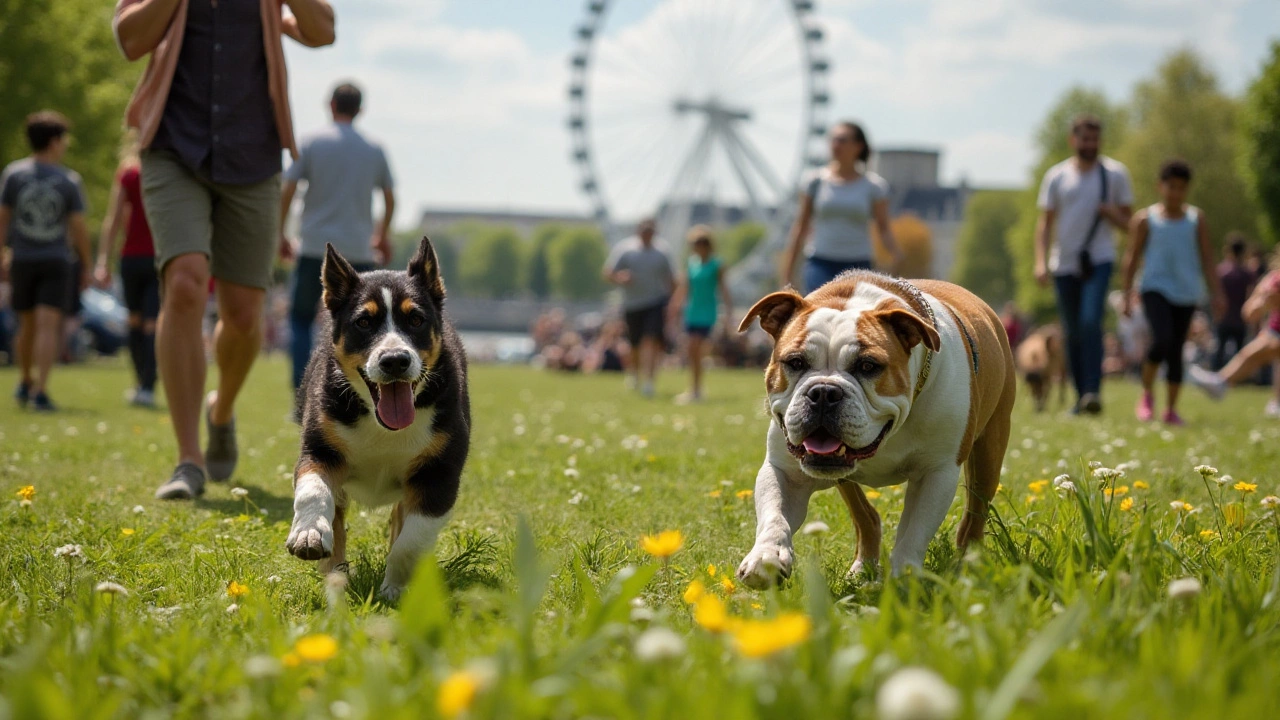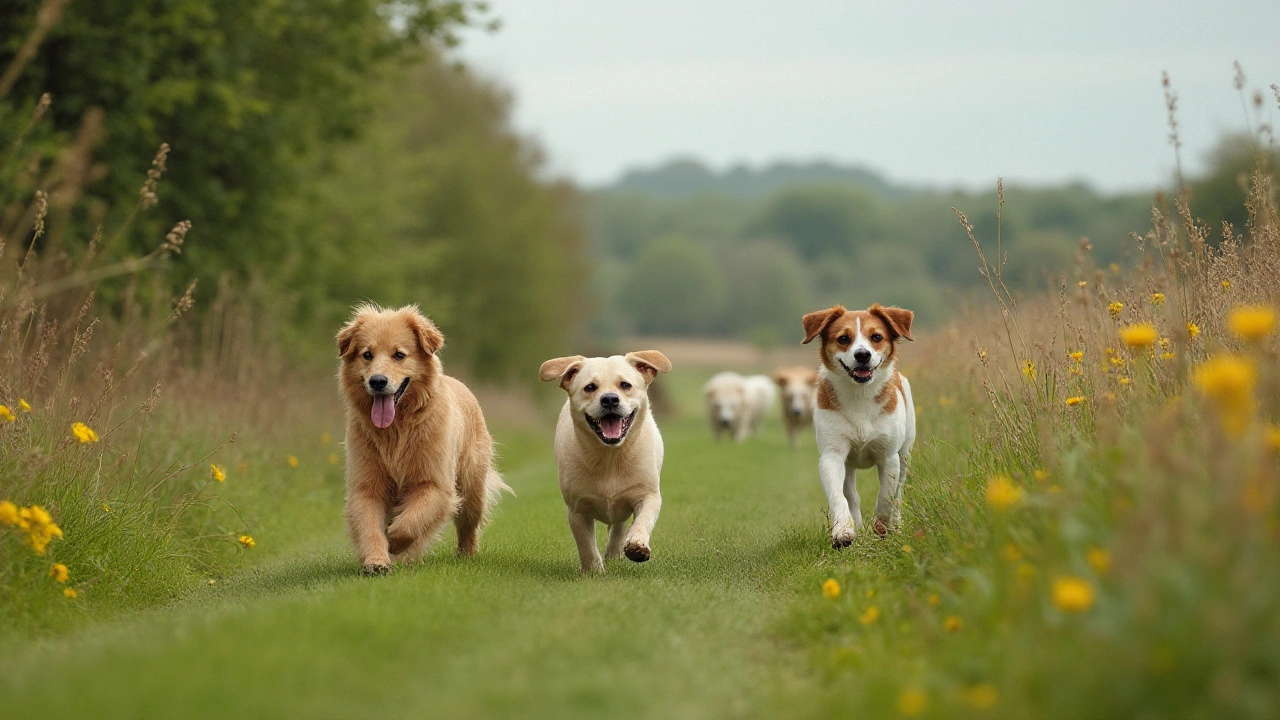Finding the right duration for your dog's daily walk can feel like a balancing act. It's not just about letting them stretch their legs; it's about meeting their unique needs to keep them healthy and happy. Many variables, including their breed, age, and overall health, can play a role in deciding the perfect walk length.
Some pups come with boundless energy, and long walks become a joyful necessity. Others may have slower paces, where a brief stroll suffices. The trick lies in observing and understanding your furry friend's cues and gradually shaping a walking routine that suits them best.
A daily walk shouldn't just address the physical aspects; it's also a chance to stimulate their minds. Exploring different environments and introducing a variety of scents can work wonders for your pup's mental health, making every walk an adventure rather than a chore.
- Factors Influencing Walk Length
- Tailoring Walks to Breed and Age
- Health Benefits of Regular Walks
- Mental Stimulation and Environment
- Practical Tips for Dog Walking
Factors Influencing Walk Length
The perfect walk for your dog isn’t a one-size-fits-all solution. One of the critical factors affecting dog walk length is the breed. Dogs come in an array of sizes and temperaments, each with its own energy levels and exercise requirements. High-energy breeds like Border Collies or Siberian Huskies might benefit from longer, more intense exercise sessions. In contrast, a breed like the Bulldog, with its more relaxed disposition, might thrive with shorter and more leisurely strolls. A dog's age is another vital component to consider. Young puppies are typically bundles of energy, but their limbs are still growing, making it essential to balance exercise with rest. Older dogs, on the other hand, might slow down due to arthritis or other age-related conditions, requiring shorter walk durations to prevent exhaustion or injury.
Size also plays a substantial role in determining how long a walk should be. A small dog, such as a Chihuahua, will have shorter legs and will tire more quickly compared to a larger breed like a German Shepherd. It's necessary to adjust the length of the walk to accommodate their proportions. Health conditions should never be ignored when planning optimal dog walk schedules. Dogs with ailments such as heart conditions might not handle the rigors of long walks; thus, shorter, more frequent outings may be better. If your dog battles obesity, consistent walking routines can aid in weight management, enhancing overall health. The personality of the dog further adds another layer of complexity. Some dogs have a natural zest for zooming around and require regular outlets for their energy, whereas others may be content with a gentle amble through the park. Observing your pet’s behavior and energy post-walk can offer clues about adjusting the walk's length appropriately.
Even the weather can significantly impact an appropriate walk length. Hot summer days might necessitate shorter walks to prevent heatstroke, while milder temperatures can allow for extended playtime outdoors. Checking the ground's temperature before heading out is another crucial step to ensure your pet’s paw pads are safe from burns on hot pavements.
Adjusting to Individual Needs
Pet fitness trackers have become a modern tool in assisting dog owners to monitor optimal exercise patterns, offering insights into not just duration but also the quality of their walks. According to a recent survey, around 34% of pet owners have turned to technology to better understand their furry companions' health needs. With these devices, you can adjust your walking routine according to the calculated activity levels, ensuring your pup receives tailor-made exercise suited to their needs.To sum it up, no single element defines the correct dog walking tips for every dog. Instead, it's an intricate blend of factors that shapes the ideal walk length. The key is careful observation, a willingness to adapt, and a focus on the unique aspects of your dog’s breed, size, age, health, and personality.
Tailoring Walks to Breed and Age
When it comes to planning the perfect walk, not all dogs are created equal. Different dog breeds demand different walking routines, and catering to these needs ensures your furry companion remains content and healthy. Small breeds like Chihuahuas or French Bulldogs might be compact in size, but they aren't necessarily lacking in energy. These little ones enjoy regular walks, though shorter distances suit their tiny strides better. In contrast, larger breeds such as Labrador Retrievers and Border Collies thrive with longer and more vigorous strolls, often requiring varied terrains to keep them interested.
The age of your dog plays a pivotal role in determining walk length too. Puppies, with their boundless energy, need shorter, more frequent walks to match their developing bones and curiosity. As they grow, so does the ability to handle longer outings. However, in their senior years, most dogs benefit from gentler, shorter walks that accommodate their declining stamina and joint health. Paying close attention to their cues allows you to adjust accordingly, ensuring they get enough exercise without unnecessary strain.
Establishing the fine line between too little and too much exercise is essential. It’s about finding the sweet spot that marries mental stimulation with physical exertion. A well-rounded regime goes beyond just physical stimulation; it taps into their senses, engaging them through varied settings and encouraging exploration. After all, a dog's walk is more than just movement; it's their window to the world. The American Kennel Club suggests that adjusting walks to the dog's pace is vital and offers a significant boost in their overall well-being. "A walk is not just a physical pursuit but a mental one too," notes Dr. Stanley Coren, a renowned psychologist specializing in canine behavior, highlighting the importance of varied exploration.
A key aspect many dog owners overlook is understanding their dog’s predisposition to energy levels. Sporting breeds, for instance, were bred with endurance in mind, making them naturally inclined towards longer, more frequent walks compared to their less active counterparts. Conversely, brachycephalic breeds like Bulldogs, which suffer from breathing difficulties, benefit from shorter durations. Recognizing these characteristics and obligations will put you on the right path to customizing your dog's walking plan.
An additional aspect worth considering is weather. Extreme temperatures can influence the ideal walk length for different breeds. Double-coated dogs, such as Huskies, might fare better in colder climates—perfect for a brisk, longer walk—while short-coated breeds like the Whippet may require a sweater in chilly weather or a shorter time outdoors. Adjusting for seasonal changes ensures your pet stays comfortable and safe during every outing.
Ultimately, each dog is different, requiring a tailored approach based on their unique needs. Discovering what they respond best to involves a combination of observation, frequent assessment, and perhaps a dash of canine psychology. With a bit of patience and adaptability, you'll be able to craft a dog walk length routine that ticks all the right boxes, ensuring your pet’s body and mind are equally engaged.

Health Benefits of Regular Walks
Regular walks for your dog aren't just a delightful pastime. They play a pivotal role in maintaining your pet's health in ways that go beyond mere exercise. Walking helps in weight management, which is crucial given the rising trend of canine obesity. By engaging in consistent walks, your pet not only maintains a healthy weight but also reduces the risk of developing related ailments like diabetes, osteoarthritis, and certain heart conditions. The activity acts as a natural avenue for energy expenditure, catering to the needs of breeds with high energy levels, ensuring they remain fit and healthy.
Moreover, regular walks contribute to improved cardiovascular health in dogs. Just as with humans, walking boosts their heart rate, enhancing circulation and promoting a healthier heart. This aspect is vital for dogs of all ages, but especially for older canine companions who might not manage more strenuous activity yet require movement to keep joints limber and spirits high. Walks help in maintaining muscle tone, which in turn offers joint support and minimizes the likelihood of strains and sprains from sudden movements or overly enthusiastic play.
Mental stimulation is another prominent benefit of consistent walking routines. Walking exposes dogs to a world outside their usual environment, filled with exciting sights, sounds, and smells. This sensory barrage can work wonders for keeping their brains active. For example, sniffing allows them to investigate their surroundings and instinctively ‘read’ their environment, much like checking a news feed! It also decreases boredom, which can lead to destructive behaviors when they are left unattended at home for extended periods. A famous dog expert once stated,
“A tired dog is a happy dog; walks give them both the mental and physical workout they crave.”
Additionally, dog walks are an opportunity to foster social interactions. Encounters with other dogs and humans teach yours to be comfortable in social settings, reducing fear and anxiety associated with unfamiliar faces. This practice can be particularly beneficial for puppies and rescue dogs needing to build confidence. The social aspect of walks helps create well-adjusted dogs that are less prone to aggression and anxiety, enhancing their overall well-being and making them a cherished part of the community. All these health benefits cumulate to form a robust foundation for your dog's happiness and longevity, with each walk being a step towards a better and healthier life for your furry friend.
Mental Stimulation and Environment
When it comes to maintaining a dog's health, mental stimulation is almost as crucial as physical exercise. A well-rounded walk should engage not only the muscles but also the mind. Picture this: your dog, nose quivering at a new scent, eyes alert to a squirrel sprinting across the path, and ears perked up at the rustle of leaves in the breeze. It's moments like these that transform a simple stroll into a captivating journey of discovery. By varying the environment in which your dog walk takes place, you open up a world of sensory experiences that keep your furry companion sharp and thriving.
Outdoor environments are filled with rich stimuli. New locations bring an assortment of smells, sights, and sounds that can be incredibly enriching for your dog. Think of these as a mental workout, challenging them to process various stimuli. If a change of scenery isn't feasible every day, don't worry. Small adjustments in the walking route can also introduce novel experiences. This could mean taking a different turn in your neighborhood or visiting a nearby park known for its diverse wildlife.
Engaging your dog's brain doesn't always require grand adventures to faraway lands. Even a familiar walk can be mentally stimulating with the right activities. Incorporating basic training exercises into your dog walking tips can add an element of fun and learning. Commands like "sit," "stay," and "leave it" challenge your pup to focus and respond, providing beneficial mental engagement. Incorporating play, like tossing a ball or frisbee in a safe area, ensures your pooch not only runs their heart out but thinks on their feet too.
Dr. Sophia Yin, a respected veterinary behaviorist, once noted,
"Dogs thrives on mental challenges and interactions. Consistent mental stimulation can help reduce anxiety and improve overall well-being."This insight highlights the importance of a stimulating environment, whether it's allowing adequate sniffing time during walks or initiating problem-solving games along the way. A simple cardboard box or a tin can filled with treats can make for excellent on-the-go puzzles to solve under your supervision.
Moreover, statistics indicate that 40% of dogs show an increase in positive behavior when varied stimuli are incorporated into their daily routines. Such engagements can enhance their capacity to learn and adapt, which is crucial for behavior management. Always keep in mind your dog's preferences and boundaries. Some may love the challenge of new games, while others may prefer the comfort of a more predictable walk with a few added twists here and there.
To optimize the benefits of mental stimulation and a varied environment during dog walk, consider integrating some fun routines regularly:
- Introduce your dog to new toys that can be part of the walk.
- Combine walks with visits to friends' homes with safe and welcoming backyards.
- Join community groups for dogs and their owners to explore together.
Optimal dog walk experiences should always prioritize your dog's preferences and needs, ensuring every walk is an opportunity for growth, joy, and healthier living.

Practical Tips for Dog Walking
Dog walking is more than just putting on a leash and heading out the door. It's about creating a safe, enriching experience that caters to your dog's needs while also being enjoyable for you. An important part of walking your dog involves choosing the right equipment. Always opt for a sturdy, reliable leash and avoid retractable ones that could potentially harm your dog or offer less control in crowded areas. A well-fitted harness, as opposed to a collar, can help prevent neck injuries and give better control, especially for larger or more energetic breeds. Reflective gear is a must if you're walking in low light conditions, ensuring both you and your dog are visible to passing traffic.
An engaging walking routine isn't a fixed one; it's adaptable to the environment and your pet's mood. Mix up your routes to include different terrains and sights. Perhaps stroll through a shaded park on hot days or a bustling street for some social training. The variety not only keeps the dog engaged but also exposes them to new stimuli, which is excellent for mental health. Navigating through different landscapes can also help improve your dog's coordination and strengthen various muscles. Always carry a portable water dish on longer walks to prevent dehydration, especially in warm weather, a critical health consideration. Also, don't forget clean-up bags to responsibly manage your dog's waste.
Teaching your dog some basic commands can enhance the walking experience. Commands like 'sit', 'stay', and 'heel' can help manage exciting situations such as meeting other dogs or people, fence-darting, or chasing after birds or squirrels. Consistency is key, so practicing these commands regularly will imprint them in your dog's repertoire of behaviors. Depending on your dog's size and breed, the typical walk for most dogs should last between 20 to 60 minutes. However, it's crucial to watch your dog's behavior and adjust accordingly. If they seem restless or disinterested, they might need a longer walk or a different activity. As Dr. Ann Hohenhaus from the Animal Medical Center aptly puts it,
"A dog's exercise needs aren't carved in stone. Knowing your pet and making walks engaging is more beneficial than sticking strictly to the clock".
To wrap up an efficient dog walk, pay attention to weather conditions, which can significantly impact your dog's health. Hot pavement can burn paw pads, so it's wise to check the pavement's temperature with your hand. If it's too hot for your touch, it's too hot for your pet. During colder months, keep an eye on icy patches or salted sidewalks. It may be suitable to invest in dog booties for such conditions. This can protect their feet from chemicals and help with traction. By keeping these practical tips in mind, you'll not only optimize your dog walk length but also enhance the quality of the time spent, ensuring that each walk is a highlight of your dog's day.









